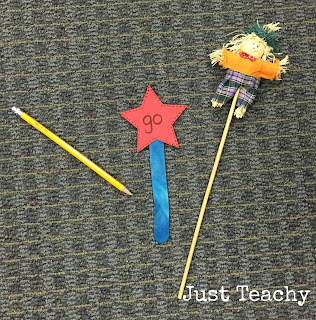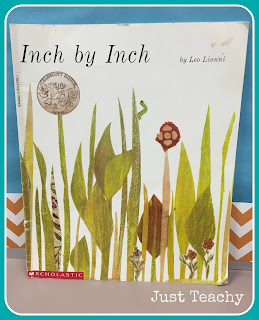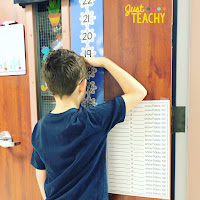This past week we completed our unit on measurement. The kids had so much fun learning about all the different types of measurement, and there were a few who would even keep their supplies on their table organized by length afterwards!
Comparing and Measuring Length
We started out learning about length. I gathered 20 different items from around our room so each student would have an item. We talked about putting the items in order by length, and how to know if one item was shorter or longer than another. I laid these three items out and we decided that it was hard to tell since they weren't lined up next to each other, or starting at the same point.
So we found a nice line in our room to line the items up against. The kids then each took a turn bringing up their item and deciding where it needed to go.
Here's all of our items lined up in order from shortest to longest.
We also traced our feet and cut them out, then measured them with uni-fix cubes.
Then the cut-out feet and strip of paper that says, "My foot is ___ cubes long" were added to their Math journals.
(This is one of the students who keeps lining up all of her things by length!)
The next day we read Inch by Inch, by Leo Lionni and completed some "wormy" measurements!
Each student measured their own gummy worm with cubes, stretched it and measured it again, then took two bites and measured it again! (And then of course ate the whole thing! YUM!)
They then each created their own "Wiggly Worms" and we lined them up by length on our big poster.
Comparing and Measuring Height
Next, we learned about height, which I introduced by reading Big Dog...Little Dog, by P.D. Eastman.
All the kids then walked around room finding things they were taller than and then shorter than.
This cutie noticed that he was shorter than me!
Non-Standard Measurement Height Strips
Throughout the year, we also always have a height strip on our classroom door. Each strip is themed for the time of year, and the students are able to measure their height using non-standard units of measure. They can also help their friends measure themselves. After they see how tall they are, they write it on the recording sheet and can compare their heights.
Below are our turkey and snowflake height strips.
You can check out all of these height strips here, on Teachers Pay Teachers.
Comparing Weight
We then learned about weight and used a balance scale to compare the weights of different items in the classroom. The students looked through magazines to choose two pictures to cut, and decide which would be the heaviest and which would be the lightest.
Then they glued the pictures onto this paper of a balance scale from Tiffany at KTeacher Tiff. Thanks for sharing!
And thanks to Kindergarten Kindergarten for a few of the other measurement ideas!
Check out these great books on measurement!
(affiliate links)


































